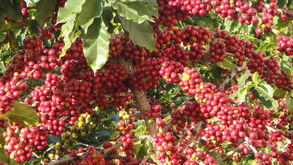The origin of the word "coffee" in the basic knowledge of coffee
Coffee (scientific name: Coffea arabica), also known as coffee tree, Arabica coffee, etc., is the national flower of Yemen. Before the 6th century AD, Yemen was called Arabian, so the coffee trees shipped from them to other places were also called Arabian coffee trees. The name coffee comes from the Arabic word "Qahwah", which means plant drink. Later, coffee spread all over the world and was named after its place of origin, "Kaffa". It was not officially named "coffee" until the 18th century.

It is an evergreen shrub of Rubiaceae in plant taxonomy. Lateral branches extend horizontally, opposite, occasionally whorled with three branches; simple leaves opposite, flowers are 2-10 clustered in leaf axils, the fruit is drupe oval, the first fruit is dark green, yellowish red or purplish red when ripe, the fruit of coffee is formed by exocarp, pulp, endocarp, silver peel, and the seeds (coffee beans) wrapped in the innermost layers mentioned above, the seeds are located in the central part of the fruit, and the parts outside the seeds are of little use.
The world's first coffee tree was found in the Horn of Africa. Coffee cultivation began in the 15th century. For hundreds of years, Yemen in the Arabian Peninsula is the only coffee producer in the world, and the market demand for coffee is very strong. In the Yemeni port of Moka, when coffee is shipped out, it often needs to be protected by heavy troops. At the same time, Yemen has also taken various measures to prevent coffee saplings from being taken out of the country. Despite many restrictions, Muslim pilgrims on the pilgrimage to the holy city of Mecca secretly brought coffee saplings back to their hometown, so coffee soon took root in India. At that time, in Venice, Italy, countless merchant ships traded perfumes, tea and textiles with Arab merchants. In this way, coffee spread to a wide area of Europe through Venice. Many European businessmen have become accustomed to drinking coffee. Later, small vendors peddling coffee appeared on the streets of many European cities, and coffee gained rapid popularity in Europe. In the 17th century, the Dutch introduced coffee to their colony of Indonesia. At the same time, the French began to grow coffee in Africa. Today, coffee has become the second largest trading product on the earth after oil! Among the countless legends of coffee discoveries, there are two legends that people are most interested in talking about, namely, the Story of the Shepherd and the Arab Monk.
Three major coffee growing areas in the world: Africa, Indonesia and Central and South America. Yemen is the first country in the world to produce coffee on a large scale as a crop. The method of cultivation and treatment of mocha coffee in Yemen today is basically the same as that of hundreds of years ago. On most coffee farms in Yemen, coffee farmers still resist the use of artificial chemicals such as chemical fertilizers. Coffee farmers plant poplars to provide shade for coffee to grow. Coffee trees are planted on steep terraces to maximize the use of less rainfall and limited land resources. Yemeni mocha beans are still shipped in a bag made of straw, unlike chemical woven bags in other places.
Yemeni coffee has been cultivated for more than 2000 years. According to statistics, coffee is cultivated in 76 countries in the world. Coffee in China was first introduced in Taiwan in 1884. In 1908, overseas Chinese brought back large and medium seeds from Malaysia to Hainan Island. At present, the main cultivation areas are Yunnan, Guangxi, Guangdong and Hainan.
Important Notice :
前街咖啡 FrontStreet Coffee has moved to new addredd:
FrontStreet Coffee Address: 315,Donghua East Road,GuangZhou
Tel:020 38364473
- Prev

Fine coffee common sense coffee please do not drink it on an empty stomach
Doctors remind members of the public not to drink coffee on an empty stomach, because coffee will stimulate gastric acid secretion, especially people with gastric ulcers should be more cautious. Coffee as a drink, drinking, according to individual circumstances, enough, generally speaking in nutrition or emphasis on a balanced diet and less use of spicy stimulating food. In addition, it is worth noting that patients with hypertension should avoid stress at work.
- Next

The basics of coffee where does coffee come from?
It has been more than 1500 years since the first discovery of coffee by shepherds in Ethiopia. This is more than 1500 years full of hardship legends and rich and colorful. In 500 years, the shepherd Caldai was the first to discover the wonderful use of coffee. In 525, the first coffee tree was planted in the Arabian Peninsula. In 1475, the first coffee shop was born in Constantinople. 1615, coffee.
Related
- Beginners will see the "Coffee pull flower" guide!
- What is the difference between ice blog purified milk and ordinary milk coffee?
- Why is the Philippines the largest producer of crops in Liberia?
- For coffee extraction, should the fine powder be retained?
- How does extracted espresso fill pressed powder? How much strength does it take to press the powder?
- How to make jasmine cold extract coffee? Is the jasmine + latte good?
- Will this little toy really make the coffee taste better? How does Lily Drip affect coffee extraction?
- Will the action of slapping the filter cup also affect coffee extraction?
- What's the difference between powder-to-water ratio and powder-to-liquid ratio?
- What is the Ethiopian local species? What does it have to do with Heirloom native species?

